Royal Mansour
- WT Travels
- africa africa africa
- June 2020
His dream metamorphosed into one of the most beautiful and serene destinations in the world. Geometric mosaic tile work, carved wooden ceilings, hand chiseled metal doors, Zellige ceramic tiles, and a second to none level of design detail intended to celebrate “happiness, wealth, and prosperity". A generous-spirited man, King Mohammad VI’s vision reflects the handcraft culture at the heart of Moroccan culture with the essence of his county’s heritage of hospitality. Hand crafted by over fifteen hundred artisans, the most prestigious address in Marrakech is known for its seemingly limitless construction budget. An eight acre oasis, the Royal Mansour consists of fifty-three, three story riads (traditional Moroccan houses each with an interior garden courtyard), winding paths of manicured courtyards Japanese persimmon trees, a.k.a the ‘food of the gods,’ pomegranate trees, the heavenly scent of jasmine vines, and the sounds of hundreds of native bird species making their homes in this lush urban sanctuary.
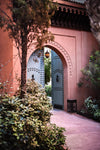
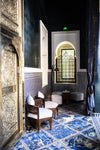
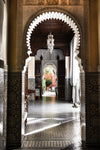
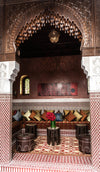
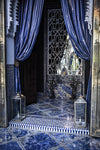
The interior color palette is a juxtaposition of contrasts that mirror the country’s north African landscapes: the red desert sand and warm, rich brown earth tones of the open common spaces transition into smaller rooms tiled and walled in the deep poetic blues of the Mediterranean Sea and the Atlantic Ocean that flank the country to the west and north.

Comfortable, quiet, and lavish, the Royal Mansour Marrakech is a testament to the history and quality of hand craftsmanship and artisanal authenticity that thrives today in a world where machines and large industry have mostly usurped the economies of countries seeking to compete on a world scale. The Royal Mansour’s design reflects the King’s commitment to the talent of his people and captures the quintessential lure and essence of old Arab walled city architecture and the resistance of its people to substitute machine modernity at the expense of losing hundreds of years of generational handicraft.
Dining in the hotel is a luxurious, attentive affair with white gloved waiters ready to provide the finest service in the world while remaining unobtrusive. Tea service is gorgeous with all the traditions embodying Moroccan tradition: the higher the tea is poured from the pot to the cup, the more revered the guest. From what seems like an impossible distance, two feet in the air, without spilling a drop, every guest is left feeling like royalty sipping the national refreshment of choice, freshly infused, double steeped mint tea.

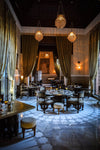
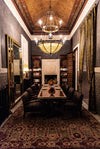
Dinner, an intimately orchestrated affair, is served in opulent surroundings with a lute-playing, handsomely costumed musician strumming pleasantly mesmerizing Arab-Andalusian style folk music in the background. The food is a blend of geographic alchemy. Moroccan and Mediterranean inspired plates deliver elevated opportunities to try the country’s meat-centered cuisine and unique combinations of spices. A subtle scent of cinnamon, cumin, ginger, cloves, fennel, anise, nutmeg, cayenne pepper mingle intriguingly in the air.
Inside the lace plastered and mosaic tiled walls of the palace there is little reason (or desire) to leave. This city within a city (steps from the exotic Marrakech souk) is a serene, quiet modern hotel in which lingering is expected and escape from urban and online chaos is truly possible. Listen to the caged birds sing from a fuchsia velvet chair while peeping through stained glass windows for a view of pomegranate and persimmon trees and other wonders of the Moorish gardens. Or, gaze at the intricacies of every handmade piece of furniture, loomed rug, or tiled surface and appreciate the luxury made by a humble people for the sole purpose of showcasing the talent and traditions of the Moroccan people.
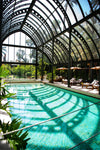
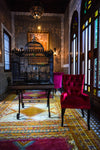
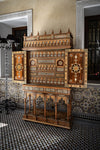
Inspired by the architectural designs of ancient Roman villas, the traditional Moroccan house, or riad, is a structure with sparsely windowed clay exterior walls and a distinctive open air interior courtyard designed to amplify the Muslim notion of personal privacy—what goes on inside, stays inside. Stately decoration, high ceilings, intimate spaces including libraries and offices with fireplaces, rich earthly color schemes, rooftop terraces with swimming pools and private hammams are Andalusian-inspired luxury residences and unlike any hotel experience in the world.
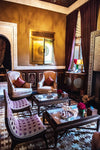
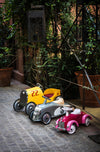
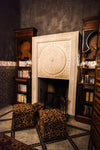


Write it on your heart that every day is the best day of the year.
Ralph Waldo Emerson

We make a life by what we give.
Winston Churchill